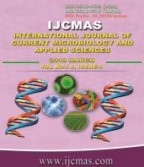


 National Academy of Agricultural Sciences (NAAS)
National Academy of Agricultural Sciences (NAAS)

|
PRINT ISSN : 2319-7692
Online ISSN : 2319-7706 Issues : 12 per year Publisher : Excellent Publishers Email : editorijcmas@gmail.com / submit@ijcmas.com Editor-in-chief: Dr.M.Prakash Index Copernicus ICV 2018: 95.39 NAAS RATING 2020: 5.38 |
Gherkin (Cucumis sativus var. anguria) is a vine type cucumber, which is a cucurbit. Gherkin differs from cucumber by its morphology. Downy Mildew is a devastating disease of gherkin, caused by the pathogen Pseudoperonospora cubensis and the pathogen primarily infects leaves, decreased in photosynthesis resulting both yield and quality of fruits reduced. The present investigation was done to control the downy mildew disease of gherkin and to check the loss of gherkin fruit yield and it was carried out with the F1 hybrid Ajax in plots of 5m x 4 m size accommodating forty plants/plot in Randomized Block Design with three replications with seven treatments during rabi season of 2018. The appearance of the first visible symptom of the disease of Gherkin was recorded at 37 Days after sowing (DAS). The fungicide Equation Pro 42 SC (262.50 g a.i./ha) showed significant minimum disease severity i.e.11.40% and maximum disease control i.e 82.41% over control, followed by T3 (210 g a.i./ha) where, disease severity is 14.25% and disease control is 76.24% over T9 (control plot). T4 and T3 are at par. The significant lowest disease incidence and highest control was recorded in T4 (Equation Pro 42 SC@262.5 g a.i/ha)and T3 (Equation Pro 42 SC @ 210.0 g a.i/ha) treated plots. After 70 days of sowing 13.33 percent disease incident was observed in T4 treated plants and it is same in T3.Curzate M8 72 and Ridomyl 72% also showed significant disease control percentage i.e 74.01% and 70.74%, respectively. Significant higher yield was found when Equation Pro 42 SC (262.50 g a.i. /ha) sprayed over crop and is at par with T3 treated plots. Equation Pro 42 SC showed no phytotoxic symptom sprayed to the gherkin crop up to 4 numbers of spraying at their different dosages.
 |
 |
 |
 |
 |